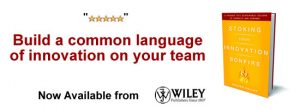Building a Better Innovation Business Model
Whether you’re a professional innovator or someone driving innovation to grow your business, chances are you need more support to get projects delivered to market.
Question: Does your innovation business model catalyze your goals or crush them?
When You Have To Deliver, You Learn To Deliver
 In 1999, Jim Collins wrote a brilliant piece in the Harvard Business Review, “Turning Goals Into Results: The Power Of Catalytic Mechanisms.” In it he addressed the problem that many managers face within their organization: they have a big goal but lack the organizational focus and courage to achieve it. Collins offered catalytic mechanisms as a potential solution.
In 1999, Jim Collins wrote a brilliant piece in the Harvard Business Review, “Turning Goals Into Results: The Power Of Catalytic Mechanisms.” In it he addressed the problem that many managers face within their organization: they have a big goal but lack the organizational focus and courage to achieve it. Collins offered catalytic mechanisms as a potential solution.
By his definition, a Catalytic Mechanism is “the crucial link between objectives and performance, [the] galvanizing devices that translate lofty aspirations into concrete reality.”
His article provided some poignant examples that span a wide range of industries. For this discussion, I’ll break his thesis down into a simple analogy: If you’re standing next to a lake and you have to catch a fish to eat, you will catch a fish.
Collins posits that this same philosophy can be applied to business problems simply by framing a firm’s most ambitious goals in this type of scenario:
- Step One: Translate your objective (I would like to catch a fish) into an imperative (I will catch a fish)
- Step Two: Give it real teeth (or I will die)
- Step Three: Get to work (start fishing… with dynamite)
Our company translated this into a performance-based compensation model that provides us with a powerful catalytic mechanism – we needed to figure out how to generate true innovations quickly, consistently and across a wide range of categories.
And in so doing, it gave us a much better understanding of the core tenets of effective innovation.
Making the Leap from Idea to Marketable Innovation
 There’s a reason the number of ideas far exceeds the number of true innovations: The lightning strike is just the beginning.
There’s a reason the number of ideas far exceeds the number of true innovations: The lightning strike is just the beginning.
Sure the blinding inspiration of a “eureka moment” is thrilling; but in reality, it’s just the first step.
As any entrepreneur will tell you, the journey from conceptualization to commercialization is often when the real breakthrough thinking happens.
As a result, it’s critical to have a well-defined understanding of what needs to be true for an innovation to get to market. Once you’ve defined “the how”, the champion should surround herself with lateral-thinking people who can react quickly to new challenges without ever losing sight of the true vision.
Skin In The Game
The power of performance-based compensation is directly transferable to any innovation initiative. Giving people a material stake in an outcome will significantly increase your chances of succeeding.
Because when people need to eat, they will come up with brilliant ways to catch a fish.
Sometimes even without the dynamite.
For More
This video outlines benefits we’ve experienced with performance-based compensation:
https://www.youtube.com/watch?v=XO6NMOXoZf8&feature=channel_page
 Pete Maulik is Chief Operating Officer at innovation consultancy Fahrenheit 212 in New York. Fahrenheit 212 delivers bigger ideas, faster to market.
Pete Maulik is Chief Operating Officer at innovation consultancy Fahrenheit 212 in New York. Fahrenheit 212 delivers bigger ideas, faster to market.
NEVER MISS ANOTHER NEWSLETTER!
LATEST BLOGS
Innovation in Pet Ownership?
Recently I heard a guy telling a story about how he goes out a few times a year on a…
Read MoreAre $300 Jeans an Innovation?
I came across an interesting article by Chip Heath and Dan Heath in Fast Company. The article hypothesizes that people’s…
Read More


